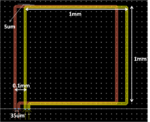grit_fire
Member level 5
Hi, all,
My goal is to find the power gain transferring from one antenna (transmitter) to another (receiver). I drew two antennas. One strange thing occurs to me is that momentum never asks me to clarify the transmitter and receiver. After simulation, I obtained s11, s12, s21, s22.
Can I know my power gain based on these parameters?
Is momentum treating one of them as transmitter and another as receiver automatically? Or my bottomline question is: can momentum give me power gain of the 2-antenna system at all??
Thank you for answering my question!
Best,
grit_fire
My goal is to find the power gain transferring from one antenna (transmitter) to another (receiver). I drew two antennas. One strange thing occurs to me is that momentum never asks me to clarify the transmitter and receiver. After simulation, I obtained s11, s12, s21, s22.
Can I know my power gain based on these parameters?
Is momentum treating one of them as transmitter and another as receiver automatically? Or my bottomline question is: can momentum give me power gain of the 2-antenna system at all??
Thank you for answering my question!
Best,
grit_fire
